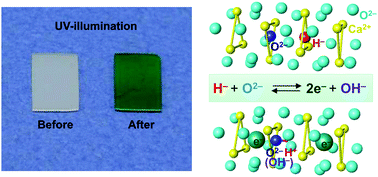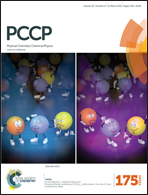Green apatites: hydride ions, electrons and their interconversion in the crystallographic channel†
Abstract
Hydride (H−) ions and electrons in channel sites of the lattice of calcium phosphate apatites are characterized. Solid-state chemical reduction using TiH2 is effective for doping of H− ions into apatites. Irradiation of the H− ion-doped apatite with ultraviolet (UV) light induces green coloration. Electron paramagnetic resonance (EPR) reveals that this colour centre is attributed to electrons captured at a vacant anion site in the crystallographic channel, forming F+ centres. Transient H0 atoms are detected at low temperatures by EPR. The concentration of UV-induced electrons in the apatite at room temperature decays according to second-order kinetics because of the chemical reactions involving two electrons; overall, electron generation and thermal decay can be described as: H− + O2− ↔ 2e− + OH−. 1H magic angle spinning nuclear magnetic resonance spectroscopy is used to identify H− ions in the apatite, which are characterized by a chemical shift of +3.4 ppm. Various types of O–H groups including OH− ions in the channel and protons bound to phosphate groups are concurrently formed, and are identified by considering the relationship between the O–H stretching frequency and the 1H chemical shift. The complementary results obtained by EPR and NMR reveal that the H− ions and transient H0 atoms are located at the centre of Ca3 triangles in the apatite, while the electrons are located in the centre of Ca6 octahedra. These findings provide an effective approach for identifying new classes of mixed-oxide-hydride or -electride crystals.


 Please wait while we load your content...
Please wait while we load your content...